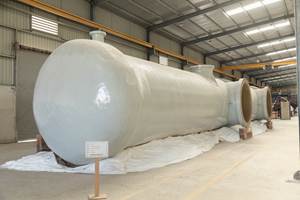Vinyl Esters Make Tough Parts For Highly Corrosive Applications
An array of case studies showcases the growing acceptance of fiberglass/vinyl ester composites in harsh industrial environments.
The direct cost of metallic corrosion in the U.S. is staggeringly high - $276 billion per year, or about 3 percent of the country's gross domestic product (GDP), according to a 2002 report entitled Corrosion Costs and Preventive Strategies in the United States, issued by the U.S. Federal Highway Administration and written by CC Technologies Laboratories Inc. (Dublin, Ohio, U.S.A.), with support from NACE International (National Association of Corrosion Engineers). Every sector of the economy pays the price, including civil infrastructure (highways and bridges), pipelines, water and sewer systems, electrical utilities, ships and aircraft, industrial plants and military installations.
While there are many strategies for fighting the problem - better inspection methods, improved management practices and life-prediction computer models - one of the most obvious solutions is to replace corrosion-prone metal materials with composites. Fiber-reinforced polymer composites made with chemical-resistant resins are virtually corrosion-free and can provide decades of maintenance-free performance, as documented by countless case studies.
Rising To The Occasion
In general, unsaturated resins, that is, resins with a higher number of double-bonded carbon atoms, can break down in the presence of polar solvents, strong acids and strong bases, because the carbon atoms offer attachment sites for the reacting molecules. More highly crosslinked, higher-weight saturated resins are more resistant because any reactive sites are nested tightly between benzene rings and are difficult to access - a phenomenon that resin manufacturers call "stearic hindrance."
While the majority of resins used for corrosion-resistant applications are polyesters, well suited for most chemical applications, vinyl esters are increasingly specified for aggressive chemical environments. The epoxide backbone chemistry, high degree of crosslinking and higher molecular weight of vinyl ester resins gives them epoxy-like performance, with the processing ease of polyesters. Bisphenol-A-based epoxy vinyl esters are generally selected for use in environments where composites will be exposed to inorganic acids, alkaline materials or salt, particularly where greater resin strength is needed to resist vibration loads. Novolac epoxy-based vinyl esters contain phenol or cresol and have even higher cross-linking density, providing outstanding thermal stability and mechanical properties for handling a wide range of chemicals, especially organic solvents.
Ashland Specialty Chemical Co.'s Composite Polymers business (Columbus, Ohio, U.S.A.) makes HETRON epoxy vinyl ester resins, a brand first commercialized in 1953 for pulp and paper bleaching applications. Ashland's new HETRON FR 992-Sb fire-resistant resin was recently selected for a 142.6m/468-ft high chimney stack liner, one of two liners planned for the Santee Cooper Power facility in Cross, S.C., U.S.A., says project engineer Al Newberry of FEMech Engineering (Harrison, Ark., U.S.A.). The resin met the project requirement of the American Society of Testing and Materials' (ASTM) E84 Class I flame spread rating of 25 or less. The resin's new Sb version has the antimony (for this project, antimony pentoxide) already mixed in, which relieves the fabricator of the responsibility for mixing the additive into the resin. In addition, HETRON's patented "F-Cat" technology makes the resin stable for long shelf life, eliminates foaming when catalysts are added and keeps exotherm low so that fabricators can work with thick laminates, if necessary, says Ashland's Ike Shank.
Related Content
Industrial equipment manufacturer expands global footprint, reaches into new markets
India-based CW Top Shops honoree EPP Composites reflects on a recently successful vertical filament winding application and new pultruded FRP rebar capabilities, as well as future opportunities.
Read MoreExel Composites supplies fiberglass profiles for Foton electric buses
Partnership with Chinese automotive manufacturer will see the implementation of pultruded profiles in various bus models, backed by weight savings, complex geometries and long life.
Read MoreTNL Applied Composites Manufacturing course begins February 2023
Hybrid, seven-session class helps participants learn the tricks of different composites manufacturing technologies from wet layup to pultrusion.
Read MorePultrusion: The basics
A primer describing what pultrusion is, its advantages and disadvantages, and typical applications.
Read MoreRead Next
Developing bonded composite repair for ships, offshore units
Bureau Veritas and industry partners issue guidelines and pave the way for certification via StrengthBond Offshore project.
Read MoreVIDEO: High-volume processing for fiberglass components
Cannon Ergos, a company specializing in high-ton presses and equipment for composites fabrication and plastics processing, displayed automotive and industrial components at CAMX 2024.
Read MorePlant tour: Daher Shap’in TechCenter and composites production plant, Saint-Aignan-de-Grandlieu, France
Co-located R&D and production advance OOA thermosets, thermoplastics, welding, recycling and digital technologies for faster processing and certification of lighter, more sustainable composites.
Read More





















